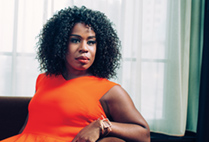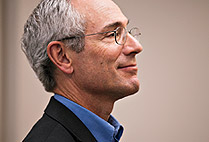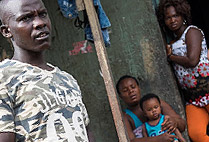Carrie Hessler-Radelet applied to the Peace Corps in her early 20s after an inspirational conversation with her grandmother, one of many family members who served with the agency. She and her husband taught in Western Samoa as Peace Corps volunteers from 1981 to 1983—an experience she describes as life-changing. After decades working in global public health, Hessler-Radelet returned to the agency—established by executive order of President John F. Kennedy—as deputy director in 2010. In June, she became the 19th director of the Peace Corps following a bipartisan vote of the US Senate confirming her appointment.
“Like so many Peace Corps volunteers,” she said at the time, “my service changed my life, shaped my passion for international development, and inspired my career. As director, I want to offer more Americans the life-defining experience of Peace Corps service and help them make a difference in the years ahead.”
Bostonia asked Hessler-Radelet (CAS’79) about her priorities as director, how the Peace Corps has evolved since its creation in 1961, and the organization’s commitment to global health.
Bostonia: What are your priorities as Peace Corps director?
Hessler-Radelet: At my Senate confirmation hearing, I laid out my vision for the future of the agency. I envision the Peace Corps as a dynamic, forward-leaning champion for international service. I see it as the place for Americans who are drawn to service abroad. And I envision a Peace Corps that is defined by its energy, innovation, and impact. As we move forward, our charge is to forge a 21st-century Peace Corps that bridges our founding ideals with the realities of our modern times.
How has the Peace Corps evolved since your own service?
Volunteers today still want to make a difference in their communities, forge strong relationships with their counterparts and neighbors, master the local language, represent our country well, and bring home a better understanding of the countries they serve—just as I did. The Peace Corps’ mission to promote world peace and friendship has remained the same for more than 50 years, and it continues to guide the work we do. But the world has changed significantly since President Kennedy founded the Peace Corps, and we have to adapt to remain relevant.

Hessler-Radelet speaks at the Global Youth Service Day, held at the Lincoln Memorial in Washington, D.C., on April 12, 2014. Photo by Alex Snyder
Technology has changed the way we communicate, and we have tremendous new opportunities. Many volunteers now use technology to augment their projects and forge relationships that benefit their communities. Technology also tethers volunteers to the United States in ways that were not possible when I served 30 years ago.
Volunteers today are also more anxious to see results from their efforts and anticipate that they will be held accountable and receive feedback on their performance. Volunteers want the skills to make a difference, and they want to be able to gauge their impact. Most important, volunteers today expect a high level of safety, security, and medical support during their service, and we have spent the last several years improving the quality of our programs to enhance volunteer support.
Our volunteers continue to be motivated by a spirit of service, but they have the tools of the 21st century.
In what nations or parts of the world is volunteer activity the highest?
The Peace Corps is active in 66 countries around the world—in Eastern Europe, Asia, the Pacific Islands, Latin America, the Middle East, and the Caribbean. About 46 percent of volunteers serve in Africa across 24 nations, and 20 percent of volunteers serve in Latin America. Zambia and Senegal are two of our largest programs, each with more than 250 currently serving volunteers. Historically, the Philippines has hosted the most volunteers, with more than 8,700 volunteers serving there since 1961. Throughout the agency’s history, Peace Corps volunteers have served in 140 countries. Earlier this month, our first class of volunteers arrived in our newest country, Kosovo.
The Peace Corps is unique among service organizations because our volunteers live and work at the community level—they go the last mile where most development agencies, and even host governments, rarely reach.

As Peace Corps acting director, Hessler-Radelet visited Togo in March 2014. Photo courtesy of the Peace Corps
Can you comment on your role in expanding the Peace Corps’ commitment to global health and HIV prevention?
I have worked in public health for the past two decades, specializing in HIV/AIDS and maternal and child health. Prior to my confirmation as Peace Corps deputy director, I was vice president and director of the Washington, D.C., office of John Snow, Inc., a global public health organization, where I oversaw the management of public health programs in more than 85 countries. My Peace Corps service was a call to arms, and my career was set from that point on in maternal and child health—a career that led me directly back to the Peace Corps 25 years later.
Because our volunteers stay for two years and integrate into their communities, they specialize in delivering services at the last mile. They work in close collaboration with other development partners and have the training, skills, and relationships in the community to ensure that life-saving health interventions are delivered effectively, owned by the community, and sustained over time. Ownership by the host country is critical to any effective global health investment, which is why Peace Corps projects are developed in collaboration with local counterparts.
One great example is the Global Health Service Partnership. The Peace Corps partners with the nonprofit Seed Global Health, the US President’s Emergency Plan for AIDS Relief, or PEPFAR, and ministries of health in Tanzania, Uganda, and Malawi to send US doctors and nurses to underserved communities to improve medical and nursing education and strengthen local health systems. By training the next generation of medical professionals and delivering hands-on care, our volunteers are bringing about sustainable change.
The Peace Corps is in your blood. Assuming you grew up hearing stories of your family members’ service, did you always know you’d volunteer, too?
Peace Corps service runs deep in my family. Four generations and six members of my family have served as Peace Corps volunteers, including my aunt, both of my grandparents, my husband, my nephew, and myself. In 1972, after successful careers, my grandparents retired and applied to the Peace Corps. They served as university professors in Malaysia. Even before they set off for Malaysia, my grandparents valued service—they were civil rights activists, managers of food kitchens for the homeless, and hosts for international students.
One day when I was in my early 20s, my grandmother sat down with me, and she asked me point-blank, “What are you going to do with your one life?” She wanted to know how I was going to make a difference in the world.
Two weeks after that conversation, my then-fiancé, Steve Radelet, and I submitted our applications for the Peace Corps. We were invited to serve in Samoa, where I taught English, history, geography, social studies, and physical education, while Steve taught math and science. The rest is history.


















































The designation in this article for Ms. Hessler-Radelet as CAS’79 is historically inaccurate. In 1979 and for many years thereafter, there was no such place as CAS at Boston University. Ms. Hessler-Radelet attended the College of Liberal Arts at Boston University (CLA). The correct designation for Ms. Hessler-Radelet is CLA’79.
Joel Krakow
Boston University College of Liberal Arts (CLA’73)